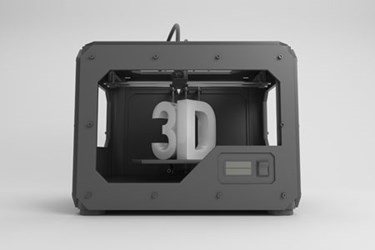3D Printed, Resorbable Drug-Releasing Implants
By Chuck Seegert, Ph.D.

Combining the concepts of 3D printing and drug-releasing, degradable plastics is the focus of a Lousiana Technical University (LTU) research team, and they appear to be making great strides forward.
Like many researchers today, the usefulness of 3D printing was apparent to the LTU team. But when pondering its usefulness, they decided to take its application to a new level.
“After identifying the usefulness of the 3D printers, we realized there was an opportunity for rapid prototyping using this fabrication method,” said Jeffery Weisman, a doctoral student in Louisiana Tech’s biomedical engineering program, in a recent press release. “Through the addition of nanoparticles and/or other additives, this technology becomes much more viable using a common 3D printing material that is already biocompatible. The material can be loaded with antibiotics or other medicinal compounds, and the implant can be naturally broken down by the body over time.”
In today’s healthcare environment, personalized medicine is becoming increasingly plausible due to advances in rapid manufacturing. This innovation may be able to provide physicians and pharmacists with another tool in their arsenal by leveraging a technology that is readily available and relatively inexpensive.
“Currently, embedding of additives in plastic requires industrial-scale facilities to ensure proper dispersion throughout the extruded plastic,” Dr. David K. Mills, a professor of biological sciences and biomedical engineering, said in the press release. “Our method enables dispersion on a tabletop scale, allowing researchers to easily customize additives to the desired levels. There are not even any industrial processes for antibiotics or special drug delivery as injection molding currently focuses more on colorants and cosmetic properties.”
The research group collaborated with an industry partner named Extrusionbot, LLC of Phoenix, AZ, according to the press release. Extrusionbot provided materials support during the development and testing process. The outcome was the fabrication of doughnut-shaped beads with a hole in the center that increased the surface area of the implant, allowing for increased drug delivery and control.
Using antibiotic implants like these can reduce systemic exposure to high concentrations of drugs, which may help with toxicity while also reducing the need for a second surgery to remove a non-resorbable drug depot.
“It is truly novel and a worldwide first to be 3D printing custom devices with antibiotics and chemotherapeutics,” Mills added in the press release.
Other forms of local drug delivery are currently being developed for similar applications. Recently, a drug releasing hydrogel was used to prevent graft rejection at the site of the transplanted tissue.
